UK Exclusive: We test Arc’teryx’s new avi pack series
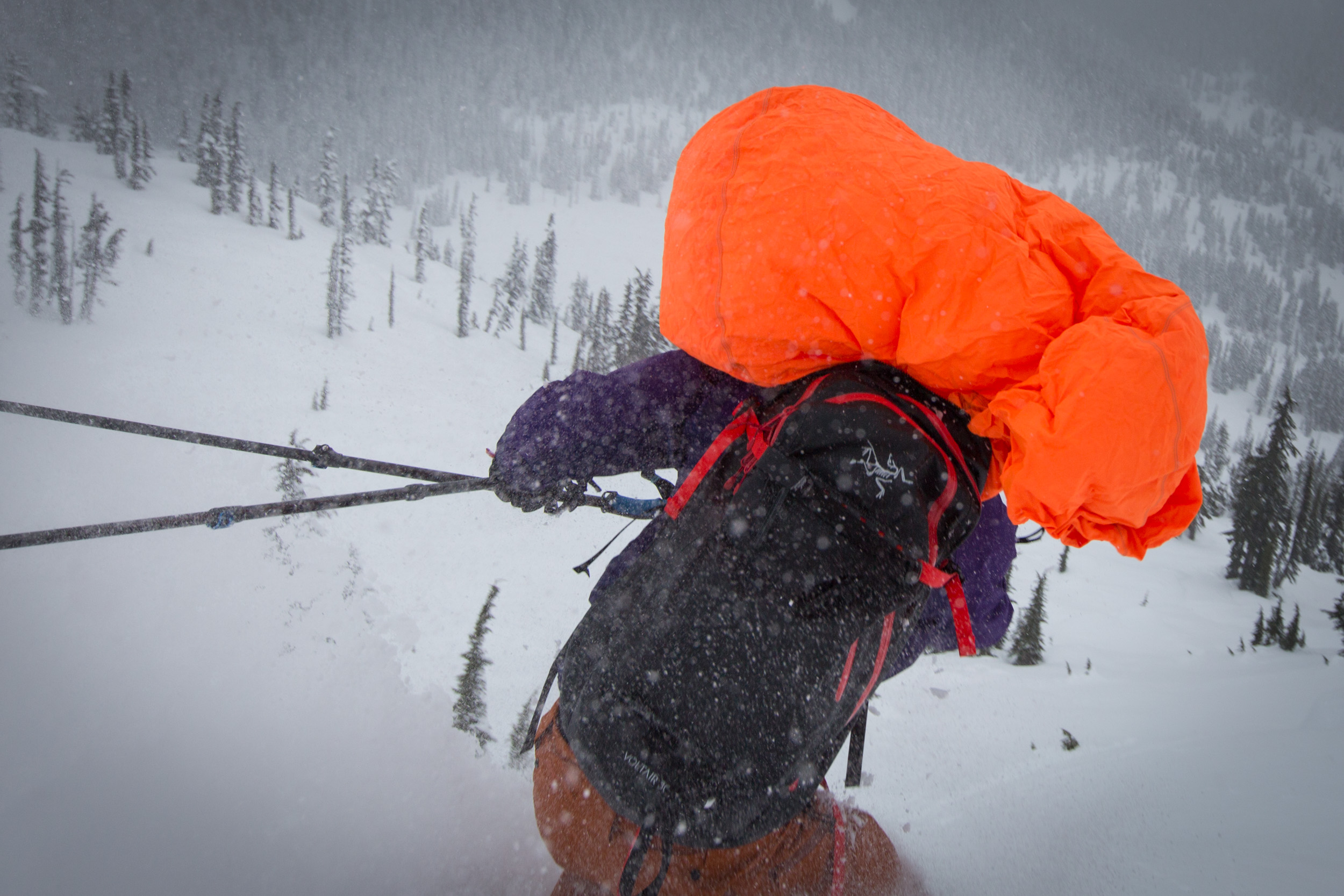

You wait ages for one revolutionary product and then two come along at once. No wonder Arc’teryx’s management stood up at their north Vancouver HQ last week and declared that this was their most important launch event in years, The Procline boot was interesting enough but with the Voltair 20 and 30L avalanche airbag, Arc’teryx has entered the burgeoning avalanche protection market with a technology all its own, and one they’ve been secretly developing for years.
When I tell you the Voltair uses a battery and a centrifugal blower to inflate the airbag time and again, instead of a compressed gas cylinder you’ll see why it’s revolutionary. No wait, doesn’t someone else do that already? Like Black Diamond and its Jetforce pack?
Ah. Now things could get complicated. So let’s just say that Arc’teryx consider the Voltair the result of such thorough research and development work that nothing comparable comes close in terms of effectiveness and reliability.
The Canadian company likes to make durable products and so the idea of having a bag that would ‘deploy’ multiple times in the backcountry really appealed. I hold up my hand at this point and admit that if I were on my second life-saving avalanche airbag deployment on the same trip, I’d be calling in a chopper to the nearest pub, leaving my gear strewn down the mountain. Forever.
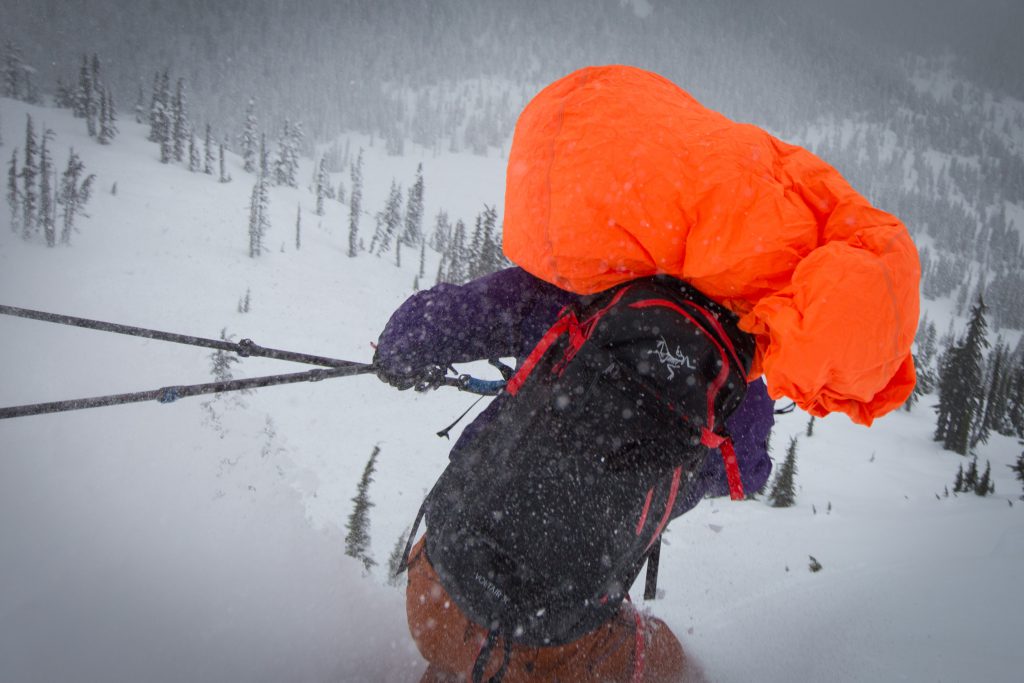
The technical challenges achieving Arc’teryx’s admirable avalanche airbag ambitions are astronomical. They include power source, initiation, inflation, oh, and airbag storage and deployment. Everything then: not least coming up with a pack to contain all this engineering.
Gordon Rose, Arc’teryx’s senior industrial designer has the look of George Lucas and the blue sky thinking to match. Coming up with an impeller, the blades within a centrifugal blower, took years and 21 iterations from London University flow dynamics experts. The lithium polymer intelligent battery from a cruise missile was good but a tad expensive. The motor was a redesigned quadcopter brush-less magnet unit with a redundancy capability that meant it worked whatever the conditions.
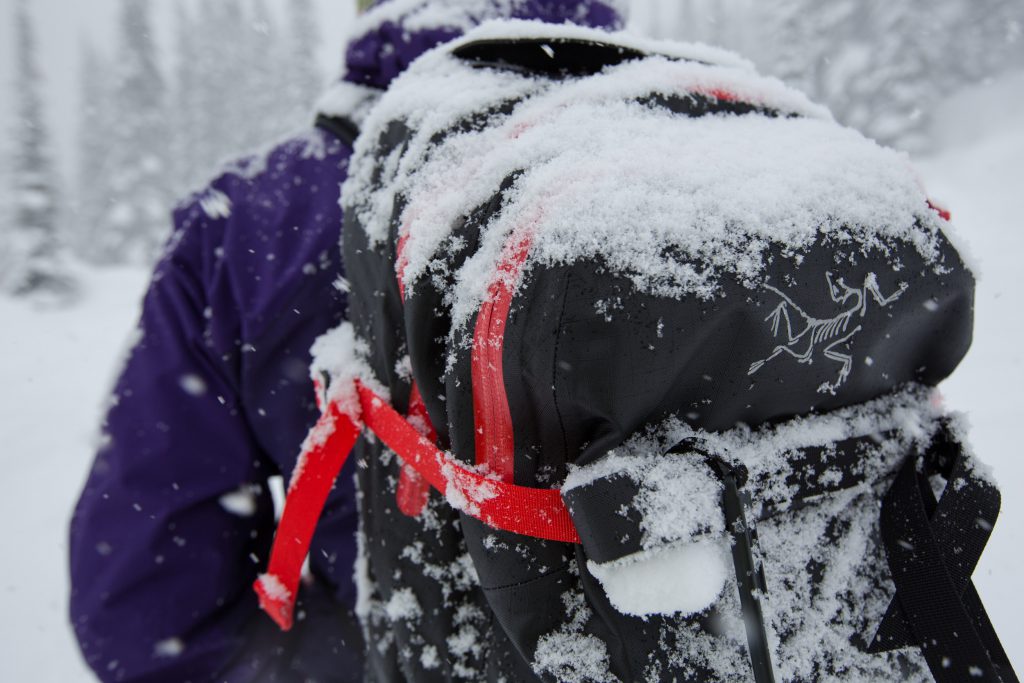
Gordon and his team opted for a centrifugal blower as the best way to inflate fast and hard (under five seconds). The battery is a “kick-ass” 22.2V pack that works at very low temperatures. So why is this technical triumph better than compressed gas, which is a lot simpler and lighter?
Gordon makes the case for re-packable airbags. The opportunity to practice, and removing the fatal hesitation factor cannot be underestimated. Dr Pascal Haegli, an avalanche safety expert presented some stats that said that when airbags weren’t deployed in an avalanche (despite being worn) 25% of the time it was because of human error. There are other advantages such as simpler air travel – where gas canisters are banned. The Voltair is fine but declare it in your hand luggage as the battery and components could freak out a scanner operator.
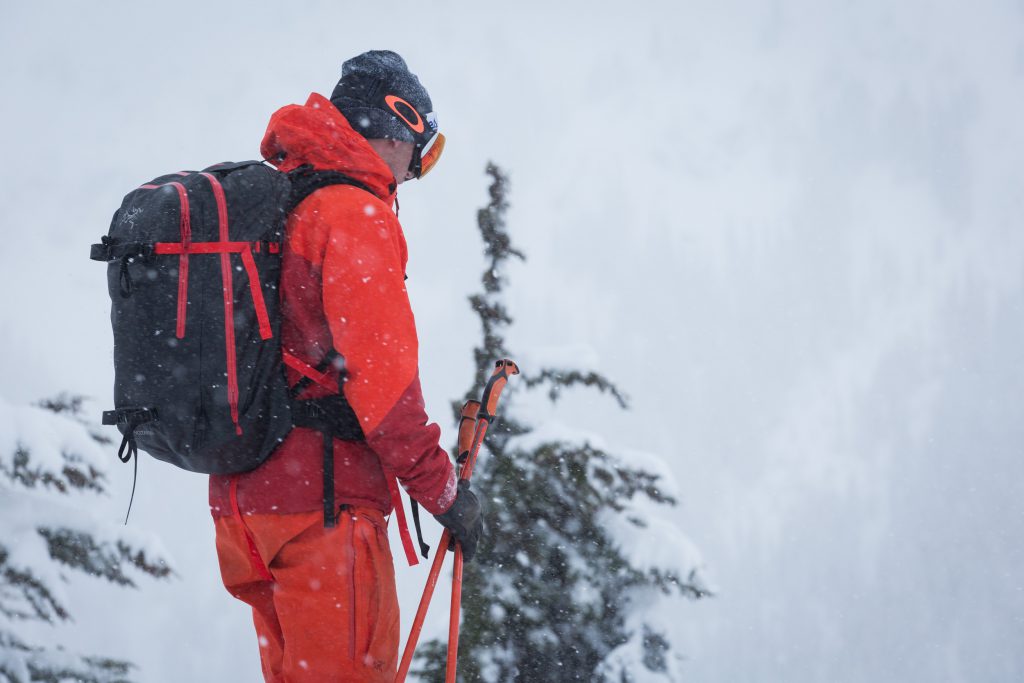
The battery is not small. It has to inflate the 150 litre balloon in less than five seconds at -30°. Arc’teryx can see other smaller batteries used on heli-skiing trips for example, where the turnaround is quicker, but it’s clear that batteries are the key technological unknown going forward – but then it is in most electronics, from cars to phones.
The Voltair runs a system check every time it’s switched on and a green light halfway down one side winks continuously. Once it goes amber you have about four inflations left. Once red you have a day’s use and one inflation left. You’d imagine that sensible margins for error are built in, given the potentially fatal consequences of system failure, but I couldn’t help thinking that cold temperatures and delays in the backcountry would have you wondering about its reliability once it flashed red.
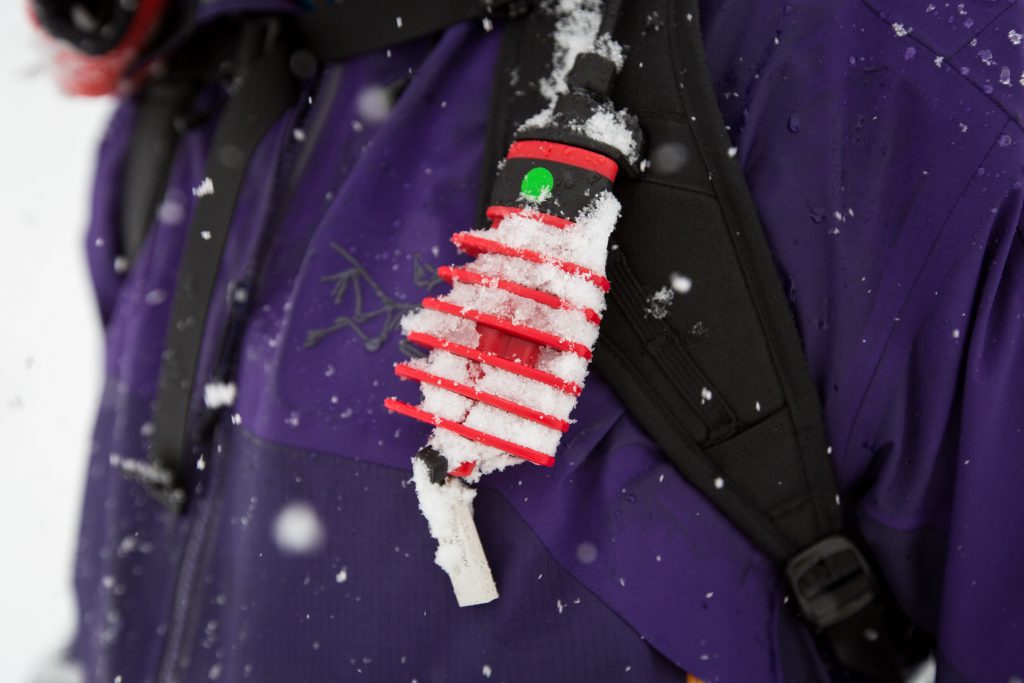
Arc’teryx admits that industry standards for its electronic system are dated and lack points of reference. The Voltair records deployments and battery function so that the company can build a larger data set. All purchasers must agree to Arc’teryx collecting this data. Is it great to be part of continuous product improvement or is it too ‘cutting edge’ for you to feel confident that everything will work infallibly in all conditions?
The pack itself is made of AC2, a tough, waterproof nylon ripstop fabric with waterproof zips and two main compartments. The airbag workings are tidily hidden away, with the battery switched on from a small side zip. For once, 30l felt like 30l of usable storage in an avalanche pack, there was plenty of room for safety gear and additional clothing and food. Arc’teryx said their research showed that when some people found they didn’t have enough room they considered taking out the compressed cylinder system. It’s not something they want a Voltair owner to ever contemplate.

Skis are lashed on solid strap mountings on the back and the red leg loop clips easily onto a wire gate on the waist belt. It was pointed out how vital strapping the loop through the legs is to the pack working as it should.
The Voltair’s trigger is a simple mechanical release cable with a red, ridged plastic handle that’s turned 180 from red dot to green to arm it, although if you forget to turn it to green and need to deploy it in a hurry, a mere 20 degree twist and pull will do the job. We were able to try this numerous times, underlining the practicality of an easily reusable system for training.
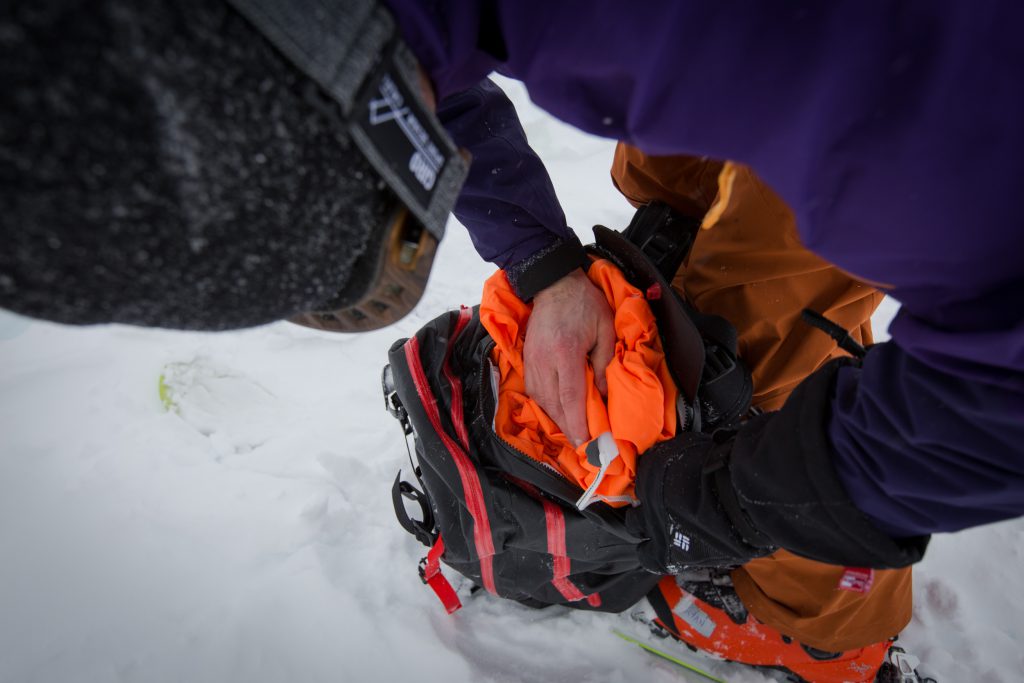
The cable releases a catch on a flap on top of the bag initiating the motor to turn the impeller in the centrifugal blower. The balloon itself blows out of a top compartment with a specially ‘weakened’ zip, where a section of zip teeth have been ground away to ensure the balloon deploys without constraint.
This is yet another challenging part of the design process and we were assured that it’s the best solution to the problem of containing the balloon securely while having to have it ready to blow in seconds, no matter your position in the avalanche, such as being upside down. It’s not what you’d call an elegant solution but given that the inflation is less ‘explosively’ powerful than a compressed gas cylinder competitor, it certainly seemed to do the job. Re-packing the balloon was straightforward but some care was needed when re-positioning the zip.
Verdict:
Dr Haegli’s research showed that wearing an airbag reduced your chances of dying in an avalanche by 41%. So it makes sense to wear one and for alpinist and backcountry brands to provide them.
Arc’teryx has been developing the Voltair’s technology longer than anyone else and feel they’ve got it right where others perhaps haven’t. During the test it worked well and the care and attention to detail is, as you’d expect from the company, top quality.
That said, there are some cons to the pros. Compressed gas systems are simpler, lighter, cheaper, and can be removed from a pack if you’re not going off-piste. Arc’teryx designs and builds with the serious alpinist and backcountry skier in mind so the Voltair won’t be for everyone.
The ability to practice and travel with the Voltair are significant advantages, although it will be interesting to see how the battery, zips etc stand up to repeatedly more use in training over the course of a season than the ‘hail Mary’ one-time compressed gas system that hopefully stays packed and ready but never used.
Product info
Voltair 20 L: £1,000
Weight: 3235 g
Voltair 30 L: SRP £1,080
Weight: 3465 g
Voltair Battery: £300
Voltair Battery Power Supply: £60